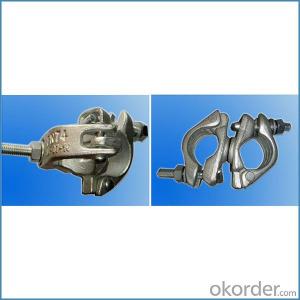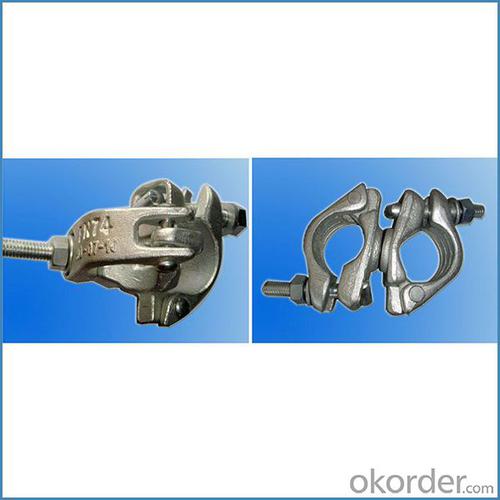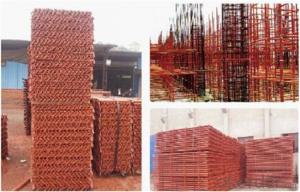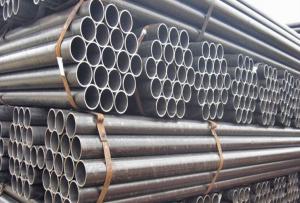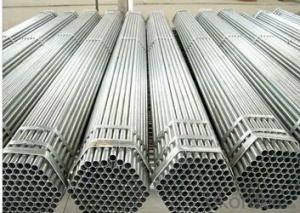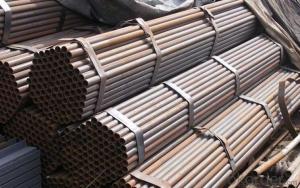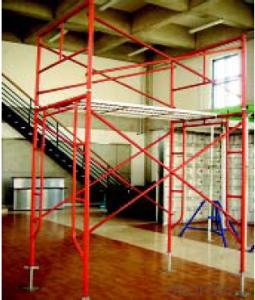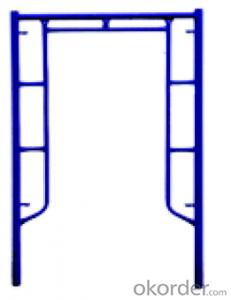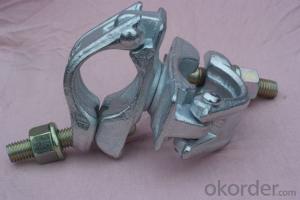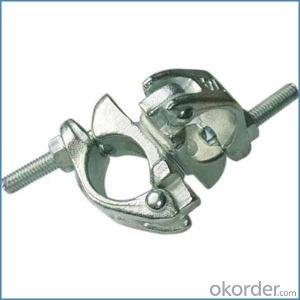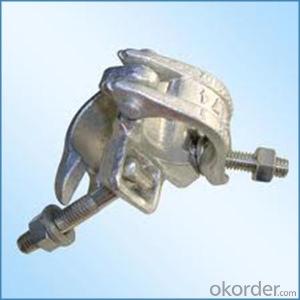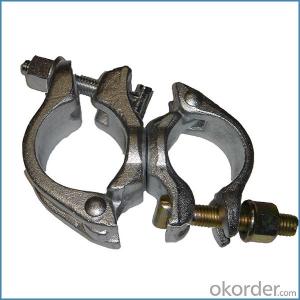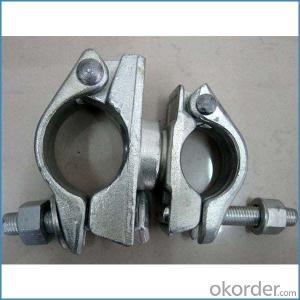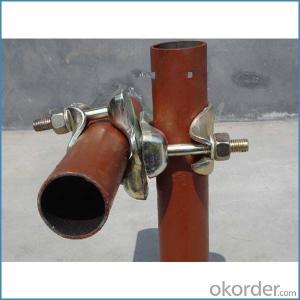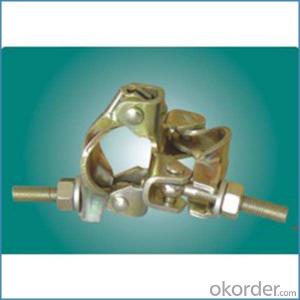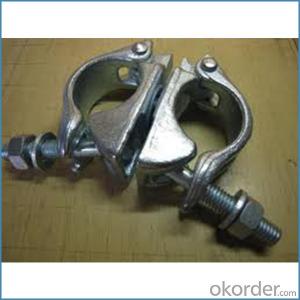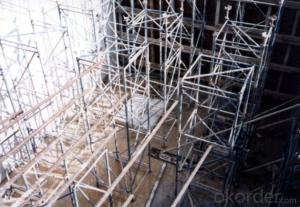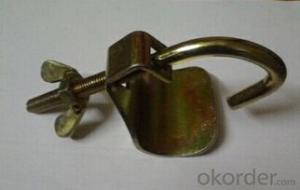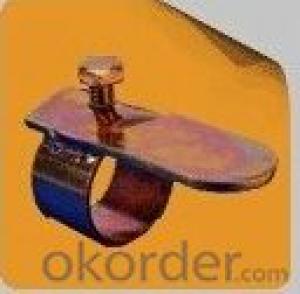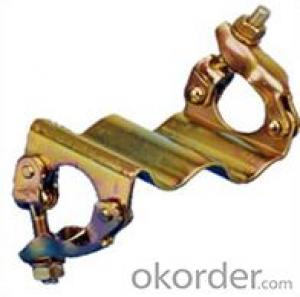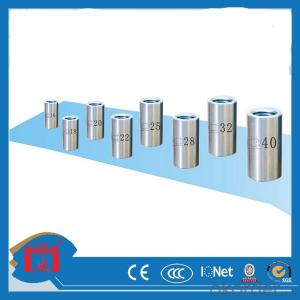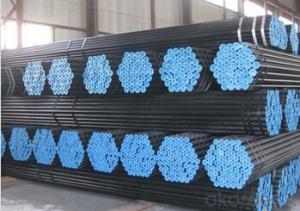Italian Double Coupler British Type for Sale
- Loading Port:
- Tianjin
- Payment Terms:
- TT OR LC
- Min Order Qty:
- 1000 kg
- Supply Capability:
- 100000 kg/month
OKorder Service Pledge
OKorder Financial Service
You Might Also Like
Italian Double Coupler British Type for Sale
Description
1.The scaffolding coupler is always used to connect the steel pipe as scaffolding system.
2.The often used coupler is swivel coupler and righ angle coupler .
3.We can provide types of scaffolding coupler according to your requirement.
4.Couoler can fix the 48.3mm scaffolding steel pipe tightly and make the whole scaffolding system more steadily.
5.Material:Q235 steel
6.Overall Size:48.3mm*48.3mm
7.Surface Finish: Galvanized/ Painted
8.Standard:BS1139,EN74
9.Package:25pcs/bag
10.Manufactuering as per customer requirements
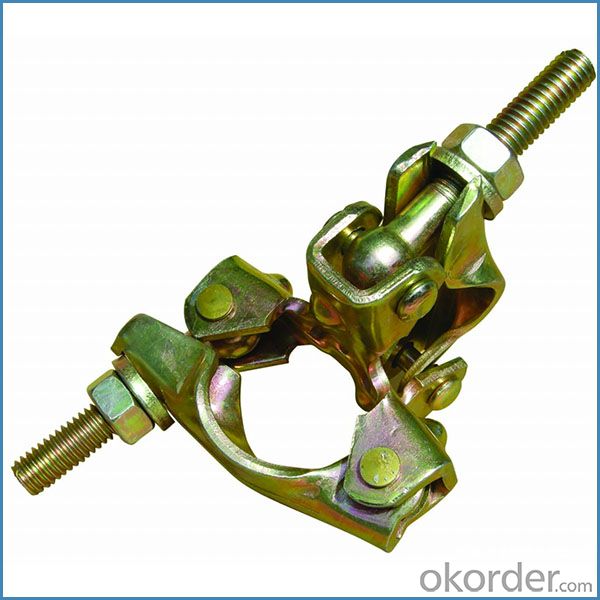
Feature
(1)Excellent Anti-Breaking—Cold Pressed Steel
(2)Outstanding Resistance Deformation
(3)Strong Anti-Dropping Ability
(4)Longtime USe
(5)Qualtity Guaranteed
(6)OEM Service
Photo
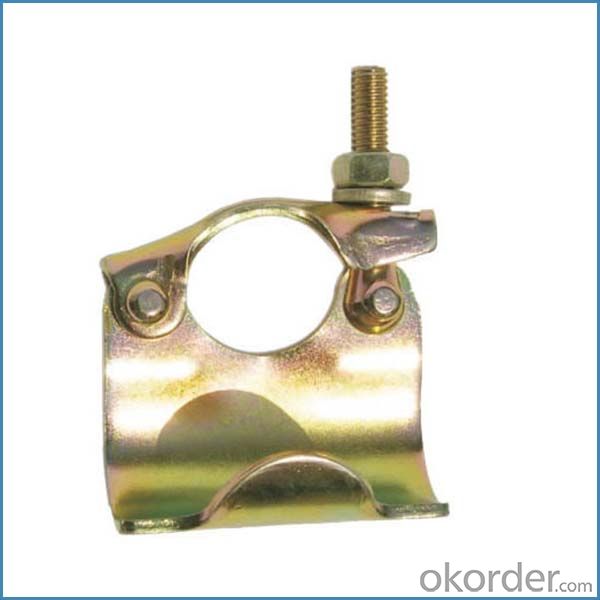
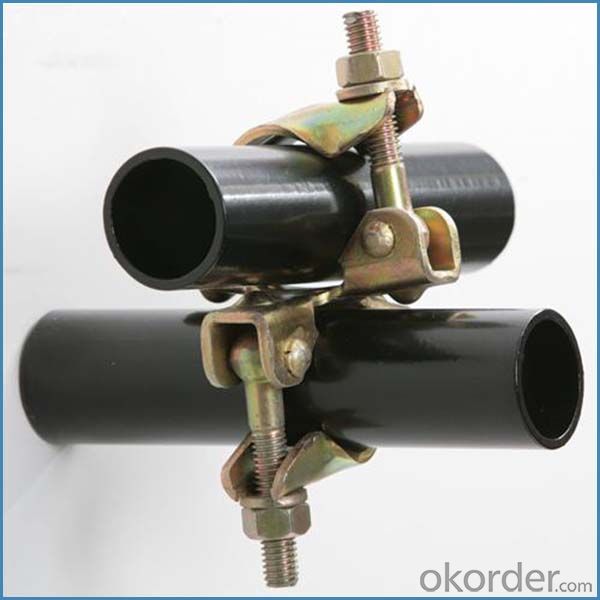
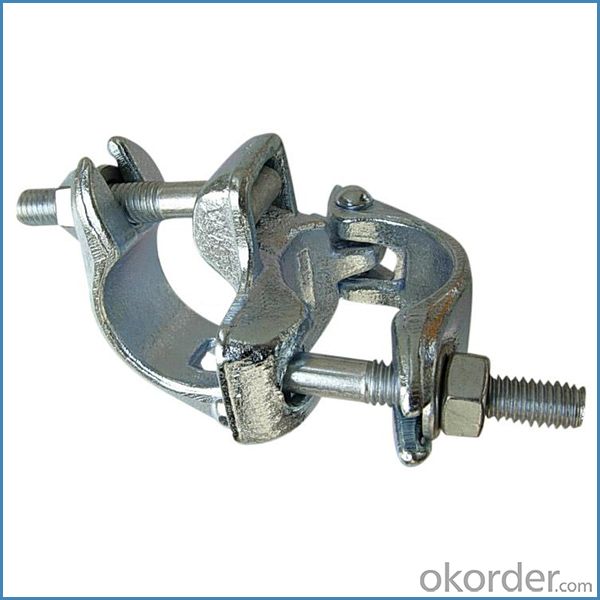
Parameter
| Material | Q235,345steel |
| Size | 48.3mm*48.3mm |
| Surface finish | Galvanized |
| Weight | 1.1kg around |
| Standard | BS1139,EN74 |
| Package | 25pcs/bag,steel pallet |
| Manufacture | As per customer requirement |
| Market | Africa, South America, the Middle East and Asia |
FAQ
Q: Are you a factory or trading company?
We are a state-owned corporation in China,dealing with various kinds of building materials.We have our holding subsidiaries.
Q: Where is your factory located? How can I visit there?
Our factory is located all around China.
Q: Can I get some samples?
Sample is free, customer only pay freight for the first time.
Q: Delivery?
10-30days. (5-15 containers)
Any question,feel free to contact us.
- Q: What are the typical load capacities of steel tube couplers in scaffolding?
- The typical load capacities of steel tube couplers in scaffolding can vary depending on the specific type and design. However, in general, they are designed to withstand loads ranging from 3 to 7 kilonewtons (kN) or approximately 660 to 1,570 pounds. It is important to refer to manufacturer specifications and guidelines to ensure proper usage and safety.
- Q: Construction construction fastener type steel pipe scaffolding safety technical specifications of the latest version of what is
- In fact, the effect of air purifier is not ideal, if the conditions, it is recommended that the family to install fresh air system, the work of the new wind system fresh air system is introduced from abroad, the vast majority of families in Europe and the United States will install fresh air system, its role is ventilation , Keep the indoor air has been fresh (long hours do not ventilate will lead to the breeding of many bacteria, oxygen concentration, health hazards), but the fresh air system to China, because China's air pollution is more serious, so the Shanghai high pole For the wind of China's fresh air system has been improved, in addition to the role of ventilation to increase the role of air purification Hao Ting fresh air system works: Hao Ting fresh air system is divided into two parts of the host and breathing treasure, the host installed in the living room or Balcony, is responsible for the outdoor air purification into the room, at the same time, breathing treasure installed in the bedroom windows, the indoor dirty air discharged to the outside, and then use the living room and the pressure difference between the bedroom, so that fresh air from the living room to the bedroom, So that the room has been kept fresh and clean air Second, the fresh air system and window Compared to the wind: 1
- Q: Are steel tube couplers adjustable for different angles in scaffolding with limited headroom?
- Yes, steel tube couplers are adjustable for different angles in scaffolding with limited headroom. They can be rotated and tightened to accommodate various angles, ensuring flexibility and adaptability in tight spaces.
- Q: Are steel tube couplers compatible with scaffolding boards and platforms?
- Yes, steel tube couplers are compatible with scaffolding boards and platforms. Steel tube couplers are commonly used in the construction industry to connect and secure steel tubes used in scaffolding systems. These couplers are designed to provide a strong and reliable connection between the steel tubes, ensuring stability and safety on the scaffold. Scaffolding boards and platforms can be easily attached to the steel tubes using these couplers, allowing for a secure and stable working surface. Additionally, steel tube couplers are versatile and can be used with various sizes and types of scaffolding boards and platforms, making them compatible with different scaffolding systems.
- Q: How do you ensure the proper alignment of scaffold tubes using steel tube couplers?
- To ensure the proper alignment of scaffold tubes using steel tube couplers, it is important to follow these steps: 1. Start by selecting high-quality steel tube couplers that are compatible with the scaffold tubes being used. 2. Clean the ends of the scaffold tubes thoroughly to remove any dirt, debris, or rust that may hinder a secure connection. 3. Align the tubes properly, ensuring that they are straight and level before attempting to connect them with the couplers. 4. Slide the steel tube coupler onto the first tube, making sure it is securely positioned. 5. Insert the second tube into the other end of the coupler, ensuring it is fully inserted and aligned properly. 6. Tighten the coupler using a wrench or a scaffold spanner to achieve the recommended torque specified by the manufacturer. 7. Check the alignment of the connected tubes visually and using a spirit level to ensure they are straight and level. 8. Repeat these steps for each junction where scaffold tubes need to be connected, ensuring proper alignment and secure connections throughout the scaffold structure. Regular inspections should also be conducted to ensure that the scaffold tubes and couplers remain aligned and secure during use.
- Q: Are steel tube couplers compatible with scaffolding projects involving temporary roofs or canopies?
- Yes, steel tube couplers are compatible with scaffolding projects involving temporary roofs or canopies. Steel tube couplers are commonly used in scaffolding systems to connect and secure the tubes together, creating a stable and durable structure. These couplers are designed to provide a strong connection between the tubes, ensuring the scaffolding can support the weight of the temporary roof or canopy. Additionally, steel tube couplers are versatile and can be used in various configurations to meet the specific requirements of the project. Therefore, they are an ideal choice for scaffolding projects involving temporary roofs or canopies.
- Q: Are steel tube couplers compatible with scaffolding systems that require specialized accessories, such as scaffold hoists or pulleys?
- Yes, steel tube couplers are generally compatible with scaffolding systems that require specialized accessories such as scaffold hoists or pulleys. Steel tube couplers are versatile and can be used to connect various scaffold components, including accessories like hoists or pulleys, making them a suitable choice for such systems.
- Q: What are steel tube couplers in scaffolding?
- Scaffolding employs steel tube couplers as devices for securely connecting and fastening steel tubes, thus creating a robust and stable scaffolding structure. These couplers, typically crafted from sturdy steel materials, are designed to bear heavy loads and offer a dependable connection. With diverse variations such as swivel, right-angle, sleeve, and putlog couplers, each serves a distinct purpose and function. As essential elements of scaffolding systems, steel tube couplers uphold the scaffolding's stability, safety, and structural integrity. Consequently, they find extensive usage in construction, maintenance, and other industries necessitating temporary elevated platforms for work at elevated heights.
- Q: Are there any specific guidelines for using steel tube couplers in scaffolding systems with limited access or space?
- Steel tube couplers in scaffolding systems with limited access or space have specific guidelines that must be followed. To ensure proper usage, it is important to select couplers that are the appropriate size and design for the confined area. Consider the following guidelines when using steel tube couplers in these situations: 1. Size and design: Opt for compact couplers with a slim profile that can fit into tight spaces. It is crucial to choose couplers specifically designed for use in confined areas or with limited access. 2. Accessibility: Evaluate the accessibility of the scaffolding system and plan the placement of the couplers accordingly. Make sure there is enough space to safely install and remove them without causing damage or compromising worker safety. 3. Weight-bearing capacity: Take into account the weight-bearing capacity of the couplers and ensure they are suitable for the specific load requirements of the scaffolding system, especially in confined spaces where support options may be limited. 4. Secure connections: Ensure the couplers are securely connected to the scaffolding structure. Tighten them properly using the recommended torque settings to ensure stability and prevent accidental disconnections. 5. Inspection and maintenance: Regularly inspect the couplers for signs of wear, damage, or corrosion. If any issues are found, replace the couplers immediately to maintain the structural integrity of the scaffolding system. 6. Compliance with regulations: It is crucial to comply with all relevant safety regulations and industry standards when using steel tube couplers in scaffolding systems with limited access or space. Follow the guidelines provided by regulatory bodies and seek guidance from experienced engineers or scaffolding specialists if needed. By adhering to these guidelines, you can ensure the safe and efficient use of steel tube couplers in scaffolding systems with limited access or space.
- Q: How do you inspect and maintain steel tube couplers for long-term use?
- To guarantee the reliability and longevity of steel tube couplers, it is imperative to inspect and maintain them properly. Here are several steps to consider: 1. Visual Examination: Routinely visually check the steel tube couplers for any indications of damage, such as cracks, dents, or corrosion. Additionally, ensure that all bolts, screws, and other fasteners are securely in place. 2. Cleansing: Regularly cleanse the couplers to eliminate dirt, debris, and other contaminants that could lead to corrosion or hinder their performance. Utilize a mild detergent or a cleaning agent suggested by the manufacturer. Refrain from using abrasive materials that could harm the couplers' surface. 3. Lubrication: Apply an appropriate lubricant to the movable components of the couplers to reduce friction and prevent wear. This step is particularly crucial if the couplers undergo frequent movement or bear heavy loads. Follow the manufacturer's recommendations regarding the type of lubricant and frequency of application. 4. Fastening: Regularly inspect and fasten all bolts, screws, or other fasteners. Over time, these elements may loosen due to vibrations or other factors. Ensure that all connections are secure, but avoid excessive tightening, as it can harm the couplers. 5. Prevention of Corrosion: Steel tube couplers are vulnerable to corrosion, especially when exposed to moisture or harsh surroundings. Apply a protective coating like paint or anti-corrosion spray to safeguard against rust. Regularly examine the couplers for any signs of corrosion and promptly address any areas that require treatment or repair. 6. Evaluation of Load Capacity: Periodically evaluate the load capacity of the steel tube couplers, particularly if there have been changes in structural requirements or if the couplers have experienced excessive loads. Consult with an engineer or the manufacturer to ensure that the couplers can safely handle the intended loads. 7. Documentation: Maintain a record of all inspections, maintenance activities, and repairs carried out on the steel tube couplers. This documentation will enable tracking of the couplers' history, identification of any recurring issues, and ensure timely maintenance. Remember, it is crucial to adhere to the manufacturer's guidelines and recommendations for inspecting and maintaining steel tube couplers, as they may provide specific instructions tailored to their product. Additionally, if any concerns or issues arise beyond your expertise, seek guidance from a professional engineer or the manufacturer.
Send your message to us
Italian Double Coupler British Type for Sale
- Loading Port:
- Tianjin
- Payment Terms:
- TT OR LC
- Min Order Qty:
- 1000 kg
- Supply Capability:
- 100000 kg/month
OKorder Service Pledge
OKorder Financial Service
Similar products
Hot products
Hot Searches
Related keywords
